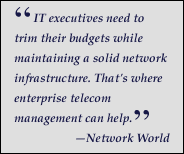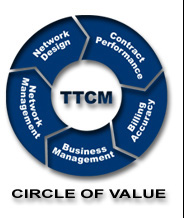




![]() When
expenses go down, profits rise, and everyone wins. That's why in leading
companies, multiple stakeholders pursue the goal of reducing telecom costs.
And when prioritizing projects, how many other initiatives do you currently
have in place that could yield a nearly immediate 500% ROI?
When
expenses go down, profits rise, and everyone wins. That's why in leading
companies, multiple stakeholders pursue the goal of reducing telecom costs.
And when prioritizing projects, how many other initiatives do you currently
have in place that could yield a nearly immediate 500% ROI?
![]()
![]() CFOs
know that every saved operating dollar is equal to boosting sales by 10
to 20 times that same amount. Because of the highly fragmented nature
of telecom costs, however, most telecom charges don't ever show up at
a CFO-level threshold of scrutiny.
CFOs
know that every saved operating dollar is equal to boosting sales by 10
to 20 times that same amount. Because of the highly fragmented nature
of telecom costs, however, most telecom charges don't ever show up at
a CFO-level threshold of scrutiny.
Financial departments are keenly focused on the costs and processes associated with approving, allocating, posting and paying the stacks of telecom bills that can pour in monthly. Automating this back office function can power huge cost reductions and performance efficiencies.
Contracts are one of the largest areas of savings that companies can generate. But does your company have the deep background and the current market knowledge to insure best pricing in a rapidly changing environment? The difference between a world-class agreement and something less may be invisible to your company, but it can cost you plenty.
The result of reducing costs is an improved bottom-line. And whether those savings come from overpayment recoveries, reduced circuit and service requirements, improved contract terms, or savings on administrative processing costs, the financial benefit is equally powerful.
![]()
![]() The
#1 responsibility for a telecom manager in today's highly connected world
is to keep the network humming with 100% reliability. Now they face added
pressure to keep that network "up" while driving its costs "down".
The
#1 responsibility for a telecom manager in today's highly connected world
is to keep the network humming with 100% reliability. Now they face added
pressure to keep that network "up" while driving its costs "down".
With changing technologies and highly dynamic businesses, it is not uncommon for enterprise networks to drift out of sync with best-practice network design. TelAssess helps companies identify and deploy the most effective and efficient networks possible to meet their communications objectives.
Then there is the ever-present issue of billing accuracy. Without a true billing engineer on staff, or an automated invoice management tool, how do the mountains of nearly undecipherable telecom bills get the scrutiny they require? All too often, they don't.
![]()
![]() We
don't make outrageous claims on savings. But we confidently stand behind
the belief that our expertise will deliver results, with an ROI that will
make a CFO smile.
We
don't make outrageous claims on savings. But we confidently stand behind
the belief that our expertise will deliver results, with an ROI that will
make a CFO smile.
![]()
©2004, TelAssess 800.657.1595
Designed by Stylus
Designs

